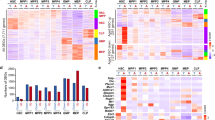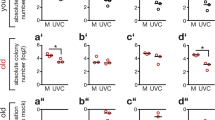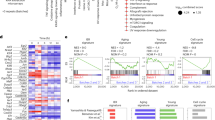Abstract
Aging is characterized by an accumulation of myeloid-biased hematopoietic stem cells (HSCs) with reduced developmental potential. Genotoxic stress and epigenetic alterations have been proposed to mediate age-related HSC loss of regenerative and self-renewal potential. However, the mechanisms underlying these changes remain largely unknown. Genetic inactivation of the plant homeodomain 6 (Phf6) gene, a nucleolar and chromatin-associated factor, antagonizes age-associated HSC decline. Immunophenotyping, single-cell transcriptomic analyses and transplantation assays demonstrated markedly decreased accumulation of immunophenotypically defined HSCs, reduced myeloid bias and increased hematopoietic reconstitution capacity with preservation of lymphoid differentiation potential in Phf6-knockout HSCs from old mice. Moreover, deletion of Phf6 in aged mice rejuvenated immunophenotypic, transcriptional and functional hallmarks of aged HSCs. Long-term HSCs from old Phf6-knockout mice showed epigenetic rewiring and transcriptional programs consistent with decreased genotoxic stress-induced HSC aging. These results identify Phf6 as an important epigenetic regulator of HSC aging.
This is a preview of subscription content, access via your institution
Access options
Access Nature and 54 other Nature Portfolio journals
Get Nature+, our best-value online-access subscription
$29.99 / 30 days
cancel any time
Subscribe to this journal
Receive 12 digital issues and online access to articles
$119.00 per year
only $9.92 per issue
Buy this article
- Purchase on Springer Link
- Instant access to full article PDF
Prices may be subject to local taxes which are calculated during checkout







Similar content being viewed by others
Data availability
Bulk and single-cell RNA-seq data that support the findings of this study have been deposited in the GEO under accession no. GSE165695. Public data analyzed in this study include expression data from HSPCs from homozygous Lig4 p.Arg278His43 mice and wild-type controls (GSE65195). We performed GSEA with gene sets available in the MSigDB (https://www.gsea-msigdb.org/gsea/msigdb/).
References
Orkin, S. H. & Zon, L. I. Hematopoiesis: an evolving paradigm for stem cell biology. Cell 132, 631–644 (2008).
Wilson, A. et al. Hematopoietic stem cells reversibly switch from dormancy to self-renewal during homeostasis and repair. Cell 135, 1118–1129 (2008).
Foudi, A. et al. Analysis of histone 2B-GFP retention reveals slowly cycling hematopoietic stem cells. Nat. Biotechnol. 27, 84–90 (2009).
Takizawa, H., Regoes, R. R., Boddupalli, C. S., Bonhoeffer, S. & Manz, M. G. Dynamic variation in cycling of hematopoietic stem cells in steady state and inflammation. J. Exp. Med. 208, 273–284 (2011).
Linton, P. J. & Dorshkind, K. Age-related changes in lymphocyte development and function. Nat. Immunol. 5, 133–139 (2004).
Beghé, C., Wilson, A. & Ershler, W. B. Prevalence and outcomes of anemia in geriatrics: a systematic review of the literature. Am. J. Med. 116, 3s–10s (2004).
Flach, J. et al. Replication stress is a potent driver of functional decline in ageing haematopoietic stem cells. Nature 512, 198–202 (2014).
Yahata, T. et al. Accumulation of oxidative DNA damage restricts the self-renewal capacity of human hematopoietic stem cells. Blood 118, 2941–2950 (2011).
Van Vlierberghe, P. et al. PHF6 mutations in T cell acute lymphoblastic leukemia. Nat. Genet. 42, 338–342 (2010).
Van Vlierberghe, P. et al. PHF6 mutations in adult acute myeloid leukemia. Leukemia 25, 130–134 (2011).
Yoshizato, T. et al. Somatic mutations and clonal hematopoiesis in aplastic anemia. N. Engl. J. Med. 373, 35–47 (2015).
Abelson, S. et al. Prediction of acute myeloid leukaemia risk in healthy individuals. Nature 559, 400–404 (2018).
Wendorff, A. A. et al. Phf6 loss enhances HSC self-renewal driving tumor initiation and leukemia stem cell activity in T-ALL. Cancer Discov. 9, 436–451 (2019).
Hsu, Y. C. et al. Phf6-null hematopoietic stem cells have enhanced self-renewal capacity and oncogenic potentials. Blood Adv. 3, 2355–2367 (2019).
Miyagi, S. et al. The chromatin-binding protein Phf6 restricts the self-renewal of hematopoietic stem cells. Blood 133, 2495–2506 (2019).
McRae, H. M. et al. PHF6 regulates hematopoietic stem and progenitor cells and its loss synergizes with expression of TLX3 to cause leukemia. Blood 133, 1729–1741 (2019).
Todd, M. A. M. & Picketts, D. J. PHF6 interacts with the nucleosome remodeling and deacetylation (NuRD) complex. J. Proteome Res. 11, 4326–4337 (2012).
Zhang, C. et al. The X-linked intellectual disability protein PHF6 associates with the PAF1 complex and regulates neuronal migration in the mammalian brain. Neuron 78, 986–993 (2013).
Wang, J. et al. PHF6 regulates cell cycle progression by suppressing ribosomal RNA synthesis. J. Biol. Chem. 288, 3174–3183 (2013).
Warmerdam, D. O. et al. PHF6 promotes non-homologous end joining and G2 checkpoint recovery. EMBO Rep 21, e48460 (2020).
Young, K. et al. Progressive alterations in multipotent hematopoietic progenitors underlie lymphoid cell loss in aging. J. Exp. Med. 213, 2259–2267 (2016).
Sun, D. et al. Epigenomic profiling of young and aged HSCs reveals concerted changes during aging that reinforce self-renewal. Cell Stem Cell 14, 673–688 (2014).
Pietras, E. M. et al. Functionally distinct subsets of lineage-biased multipotent progenitors control blood production in normal and regenerative conditions. Cell Stem Cell 17, 35–46 (2015).
Dykstra, B., Olthof, S., Schreuder, J., Ritsema, M. & de Haan, G. Clonal analysis reveals multiple functional defects of aged murine hematopoietic stem cells. J. Exp. Med. 208, 2691–2703 (2011).
Beerman, I. et al. Functionally distinct hematopoietic stem cells modulate hematopoietic lineage potential during aging by a mechanism of clonal expansion. Proc. Natl Acad. Sci. USA 107, 5465–5470 (2010).
Wagers, A. J. & Weissman, I. L. Differential expression of alpha2 integrin separates long-term and short-term reconstituting Lin-/loThy1.1loc-kit+ Sca-1+ hematopoietic stem cells. Stem Cells 24, 1087–1094 (2006).
Benveniste, P. et al. Intermediate-term hematopoietic stem cells with extended but time-limited reconstitution potential. Cell Stem Cell 6, 48–58 (2010).
Haas, S. et al. Inflammation-induced emergency megakaryopoiesis driven by hematopoietic stem cell-like megakaryocyte progenitors. Cell Stem Cell 17, 422–434 (2015).
Gekas, C. & Graf, T. CD41 expression marks myeloid-biased adult hematopoietic stem cells and increases with age. Blood 121, 4463–4472 (2013).
Shin, J. Y., Hu, W., Naramura, M. & Park, C. Y. High c-Kit expression identifies hematopoietic stem cells with impaired self-renewal and megakaryocytic bias. J. Exp. Med. 211, 217–231 (2014).
Copley, M. R. et al. The Lin28b–let-7–Hmga2 axis determines the higher self-renewal potential of fetal haematopoietic stem cells. Nat. Cell Biol. 15, 916–925 (2013).
Ito, K. et al. Gene targeting study reveals unexpected expression of brain-expressed X-linked 2 in endocrine and tissue stem/progenitor cells in mice. J. Biol. Chem. 289, 29892–29911 (2014).
Essers, M. A. et al. IFNα activates dormant haematopoietic stem cells in vivo. Nature 458, 904–908 (2009).
Chambers, S. M. et al. Aging hematopoietic stem cells decline in function and exhibit epigenetic dysregulation. PLoS Biol. 5, e201 (2007).
Flohr Svendsen, A. et al. A comprehensive transcriptome signature of murine hematopoietic stem cell aging. Blood 138, 439–451 (2021).
Wilson, A. et al. c-Myc controls the balance between hematopoietic stem cell self-renewal and differentiation. Genes Dev 18, 2747–2763 (2004).
Luis, T. C. et al. Wnt3a deficiency irreversibly impairs hematopoietic stem cell self-renewal and leads to defects in progenitor cell differentiation. Blood 113, 546–554 (2009).
Reynolds, N. et al. NuRD suppresses pluripotency gene expression to promote transcriptional heterogeneity and lineage commitment. Cell Stem Cell 10, 583–594 (2012).
Choudhury, A. R. et al. Cdkn1a deletion improves stem cell function and lifespan of mice with dysfunctional telomeres without accelerating cancer formation. Nat. Genet. 39, 99–105 (2007).
Beerman, I. & Rossi, D. J. Epigenetic regulation of hematopoietic stem cell aging. Exp. Cell. Res. 329, 192–199 (2014).
Chistiakov, D. A., Voronova, N. V. & Chistiakov, A. P. Ligase IV syndrome. Eur. J. Med. Genet. 52, 373–378 (2009).
Nijnik, A. et al. DNA repair is limiting for haematopoietic stem cells during ageing. Nature 447, 686–690 (2007).
Rucci, F. et al. Homozygous DNA ligase IV R278H mutation in mice leads to leaky SCID and represents a model for human LIG4 syndrome. Proc. Natl Acad. Sci. USA 107, 3024–3029 (2010).
Riballo, E. et al. Identification of a defect in DNA ligase IV in a radiosensitive leukaemia patient. Curr. Biol. 9, 699–702 (1999).
O’Driscoll, M. et al. DNA ligase IV mutations identified in patients exhibiting developmental delay and immunodeficiency. Mol. Cell 8, 1175–1185 (2001).
Pang, W. W., Schrier, S. L. & Weissman, I. L. Age-associated changes in human hematopoietic stem cells. Semin. Hematol. 54, 39–42 (2017).
Geiger, H., de Haan, G. & Florian, M. C. The ageing haematopoietic stem cell compartment. Nat. Rev. Immunol. 13, 376–389 (2013).
Kramer, A. & Challen, G. A. The epigenetic basis of hematopoietic stem cell aging. Semin. Hematol. 54, 19–24 (2017).
Vijg, J. From DNA damage to mutations: all roads lead to aging. Ageing Res. Rev. 68, 101316 (2021).
Merico, D., Isserlin, R., Stueker, O., Emili, A. & Bader, G. D. Enrichment map: a network-based method for gene-set enrichment visualization and interpretation. PLoS ONE 5, e13984 (2010).
Acknowledgements
This work was supported by NIH grants R35 CA210065 (to A.A.F.), R01 CA206501 (to A.A.F.) and P30 CA013696 (Confocal and Specialized Microscopy Shared Resource, Flow Cytometry Shared Resource, Genomics Shared Resource, Herbert Irving Comprehensive Cancer Center). J.A.B. was supported by funding from the National Cancer Institute of the National Institutes of Health (K99 CA267168). The funders had no role in study design, data collection and analysis, decision to publish or preparation of the manuscript. We are grateful to E. Passegué at the Columbia Stem Cell Initiative for critical reading of the manuscript.
Author information
Authors and Affiliations
Contributions
A.A.W. and A.A.F. designed the study. A.A.W., S.A.Q., J.A.B., S.A., M.B. and T.G. performed research. S.A.Q. performed bioinformatics analyses. A.A.F. and T.P. supervised research. A.A.F. and wrote the manuscript with A.A.W., S.A. and S.A.Q.
Corresponding authors
Ethics declarations
Competing interests
A.A.F., J.A.B. and S.A. are currently employed by Regeneron Pharmaceuticals. A.W. is currently employed by Calico. S.A.Q., M.B., T.G. and T.P. declare no competing interests.
Peer review
Peer review information
Nature Aging thanks Michael Milsom and the other, anonymous, reviewer(s) for their contribution to the peer review of this work.
Additional information
Publisher’s note Springer Nature remains neutral with regard to jurisdictional claims in published maps and institutional affiliations.
Extended data
Extended Data Fig. 1 Cell cycle analysis of scRNA-sequencing data from Phf6 wild-type and knockout hematopoietic stem and progenitor cells (total LSK cells).
a, UMAP projection of scRNA-Seq data generated from LSK cells harvested from 16-week and 24-month-old Phf6 wild-type and knockout mice (n = 12, 3 samples per genotype, per age group). Cells are colored according to the cell cycle phase. b, UMAP projection of scRNA-Seq data as in a, indicating the cell cycle score for S phase. c. UMAP projection of scRNA-Seq data as in a, indicating the cell cycle score for and G2M. Data relates to Fig. 1.
Extended Data Fig. 2 Phf6 upregulation in old HSCs.
Relative gene expression levels of Phf6 based on RNA-Seq data from sorted LT-HSCs from young (12-week-old) and aged (24-month-old) wild-type C57/BL6 mice. Data relates to Fig. 5.
Extended Data Fig. 3 Enrichment of an aged LT-HSC-associated gene-set signature in the old scRNA-Seq wild-type HSC cluster compared with young HSC controls.
GSEA enrichment plots of a gene-set comprised of top 250 genes upregulated and downregulated in old LT-HSCs in the scRNA-Seq HSC cluster of 16-week vs. 24-month-old Phf6 wild-type mice. Normalized enrichment score (NES) and the FEWER p-value are shown. Data relates to Fig. 1.
Extended Data Fig. 4 Differential gene expression and pathway analysis comparison between scRNA-Seq sub-clusters identified in the HSC sub-population of total LSK cells in bone marrow of Phf6 wild-type and knockout aged mice.
Network representation of gene sets enriched in the old HSC subcluster i (enriched in Phf6 knockout HSCs from old mice) and HSC subcluster ii (enriched in Phf6 wild-type HSCs from old mice). Node size indicates the number of genes in each represented gene-set. The width of the edges indicates fraction of shared genes between gene-set pairs. Data relates to Fig. 1.
Extended Data Fig. 5 Evaluation of hematopoietic stem and progenitor-cell population representation from young and aged Phf6 wild-type and knockout mice.
a, Representative FACS plots of the total stem and progenitor subset (LSK) and committed myeloid progenitor population (MyP) frequency in the bone marrow of 8-week-old Phf6 wild-type (Phf6+/Y) and hematopoietic-specific knockout mice (Phf6−/Y). b, Quantification of absolute cell numbers of LSK and MyP populations, as in a. Total cell numbers are shown for n = 5 animals per group, per genotype. c, Representative FACS plots of LSK and MyP population frequency in the bone marrow of 24-month-old Phf6 wild-type (Phf6+/Y) and knockout mice (Phf6 −/Y). d, Quantification of absolute cell numbers of LSK and MyP populations, as in c. Total cell numbers are shown for n = 8 and n = 9 animals per genotype, respectively. e. Quantification of absolute cell number/animal of LT-HSC, ST-HSC, MPP2, MPP3 and MPP4 populations in the bone marrow of 24-month-old Phf6 wild-type (Phf6+/Y) and knockout mice (Phf6−/Y). Total cell numbers are shown for n = 8 and n = 9 animals per genotype, respectively. f, Gating strategy for phenotypic identification and quantitation of LT-HSC, ST-HSC, MPP2, MPP3 and MPP4 populations by FACS. g, Gating strategy for phenotypic identification and quantitation of CLP progenitor cells by FACS. h-j, Complete blood count analysis of white blood cells (WBCs), neutrophils (NE) and lymphocytes (LY). k-n, Complete blood count analysis of hematocrit (HCT), red blood cells (RBC), hemoglobin (Hb) and mean corpuscular volume (MCV). o, Complete blood count analysis of platelets (PLT). Peripheral blood counts were scored in 4-month-old wild-type (Phf6+/Y), 4-month-old knockout (Phf6−/Y), 21-month-old wild-type (Phf6+/Y) and 21-month-old knockout (Phf6−/Y) animals (n = 4 mice per group). Graphs represent mean ± SD and p-values were assessed using two-tailed unpaired Student’s t-test.
Extended Data Fig. 6 Surface expression analysis of age-associated markers in LT-HSCs.
a, Representative histograms depicting surface CD150 expression and quantitation intervals in LT- and ST-HSCs (total CD48neg LSK cells) from aged Phf6 wild-type (Phf6+/Y) and knockout mice (Phf6-/Y). b, Representative histograms depicting surface CD49b expression in LT-HSCs from aged Phf6 wild-type and knockout mice. c, Representative histograms depicting surface CD41 expression in LT-HSCs from aged Phf6 wild type and knockout mice. d, Representative contour plots depicting surface CD117 expression in LT-HSCs from aged Phf6 wild-type and knockout mice. Representative data relates to Fig. 2.
Extended Data Fig. 7 LT-HSC differentiation potential and surface expression analysis of age-associated markers in HSCs recovered after secondary transplantation of LT-HSCs from old Phf6 wild-type and knockout donor mice.
a, Representative contour plots of CD150 and CD48 surface expression and quantitation gates for LT-HSC, ST-HSC, MPP2 and MPP3 stem and progenitor cell subsets within the bone-marrow LSK fraction of recipient mice of serially transplanted aged Phf6 wild-type and knockout LT-HSCs. b, Representative pseudo-color density plots depicting the frequency of donor-derived (CD45.2+) and residual host-derived (CD45.1+) cells in peripheral blood of mice serially transplanted with aged Phf6 wild-type and knockout LT-HSCs. c, Representative histograms indicating CD150, CD49b and CD41 expression on donor-derived LT-HSCs recovered from mice transplanted with aged Phf6 wild-type and knockout LT-HSCs. Representative data relates to Fig. 3.
Supplementary information
Source data
Source Data Fig. 2
Statistical source data.
Source Data Fig. 3
Statistical source data.
Source Data Fig. 4
Statistical source data.
Source Data Fig. 7
Statistical source data.
Source Data Fig. 7
Unprocessed images.
Source Data Extended Data Fig. 5
Statistical source data.
Rights and permissions
Springer Nature or its licensor (e.g. a society or other partner) holds exclusive rights to this article under a publishing agreement with the author(s) or other rightsholder(s); author self-archiving of the accepted manuscript version of this article is solely governed by the terms of such publishing agreement and applicable law.
About this article
Cite this article
Wendorff, A.A., Aidan Quinn, S., Alvarez, S. et al. Epigenetic reversal of hematopoietic stem cell aging in Phf6-knockout mice. Nat Aging 2, 1008–1023 (2022). https://doi.org/10.1038/s43587-022-00304-x
Received:
Accepted:
Published:
Issue Date:
DOI: https://doi.org/10.1038/s43587-022-00304-x



